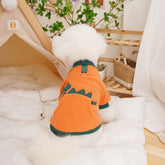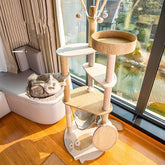How to Reupholster a Cat Tower: A Step-by-Step Guide
Table of Contents
- Introduction
- Understanding the Importance of Reupholstering
- Tools and Materials Needed
- Step-by-Step Guide to Reupholstering a Cat Tower
- Conclusion
- FAQ
Introduction
Every cat owner knows that the joy of having a feline friend comes with its own unique challenges. One of these challenges is ensuring that our cats have suitable places to scratch, climb, and lounge. Cat towers provide that haven, but over time, these beloved structures can become worn and unsightly, often leading us to consider replacements. However, instead of discarding an old cat tower, we have the perfect opportunity to breathe new life into it through reupholstering.
Did you know that an estimated 70% of cat owners have a cat tree or tower in their home? This statistic showcases how essential these pieces of furniture are for our furry companions. Not only do they provide entertainment and exercise, but they also serve as a safe space for our cats to relax. By reupholstering a cat tower, we can save money, reduce waste, and create a piece that fits seamlessly into our home decor while keeping our pets happy.
In this blog post, we will dive into the nitty-gritty of reupholstering a cat tower, offering practical tips and techniques to ensure that your DIY project is a success. We'll cover everything from selecting materials to ensuring structural integrity, providing you with a comprehensive guide that will empower you to transform an old cat tower into a beautiful, functional piece that your cats will adore.
Let’s embark on this journey together as we explore the art of reupholstering cat towers. By the end of this post, you will be equipped with the knowledge and confidence to tackle this project, turning a once-dingy structure into a vibrant and inviting playground for your beloved feline companions.
Understanding the Importance of Reupholstering
Before we jump into the practicalities of how to reupholster a cat tower, let’s take a moment to reflect on why this project is not just an aesthetic choice, but a significant one for both you and your pet.
Reupholstering a cat tower can serve several purposes:
- Cost-Effective Solution: Purchasing a new cat tower can be expensive, especially considering that many high-quality options can cost well over a hundred dollars. Reupholstering allows you to refresh your cat's environment without breaking the bank.
- Environmental Responsibility: In a world increasingly aware of environmental issues, reusing and repurposing items, such as cat towers, contributes to sustainability. By choosing to reupholster instead of dispose, we are reducing waste and promoting a more eco-friendly lifestyle.
- Customization: Reupholstering gives you the opportunity to express your personal style. You can choose fabrics and colors that complement your home decor, ensuring that your cat tower becomes a cohesive part of your living space.
- Enhanced Comfort: Over time, the materials on a cat tower can degrade, leading to a less comfortable experience for your pet. Reupholstering allows you to replace worn-out fabrics and padding, ensuring that your cat has a cozy and inviting place to relax.
- Strengthening the Bond: Engaging in DIY projects with your pet in mind can deepen the bond you share. As you create a refreshed space for your cat, you are also demonstrating your love and care, reinforcing the relationship you hold dear.
With these points in mind, let’s delve into the practical steps of reupholstering your cat tower and how to do it effectively.
Tools and Materials Needed
Before we get started with the actual reupholstering process, it’s essential to gather all the necessary tools and materials. Having everything on hand will make the process smoother and more enjoyable.
Tools
- Heavy-Duty Staple Gun: This will be crucial for securing the new fabric to the structure.
- Staples: Make sure to have enough staples that are compatible with your staple gun.
- Screwdriver: To remove any screws that may be holding parts of the cat tower together.
- Pliers: Useful for pulling out any stubborn staples or nails.
- Utility Knife: Ideal for cutting the new fabric and trimming excess material.
- Measuring Tape: To measure the fabric needed accurately.
- Hammer: For any nails or adjustments you may need to make.
- Drill: If you need to make or reinforce holes for screws.
Materials
- New Upholstery Fabric: Choose a durable fabric that can withstand scratching and wear. Options include canvas, upholstery fabric, or even carpet remnants.
- Foam Padding: If the existing padding is worn out, consider replacing it with new foam for added comfort.
- Sisal Rope: If your cat tower has scratching posts, you may want to rewrap them with new sisal rope for freshness.
- Wood Glue: For reinforcing wooden parts or securing the sisal rope.
- Paint (Optional): If you wish to spruce up the wooden elements of the cat tower, consider using non-toxic paint.
With the tools and materials at the ready, we can begin the reupholstering process.
Step-by-Step Guide to Reupholstering a Cat Tower
Now that we have everything we need, let’s walk through the steps of reupholstering a cat tower. Each step is important to ensure a successful outcome, so let’s take our time and follow the process carefully.
Step 1: Prepare the Area and the Cat Tower
Before starting the project, it’s crucial to prepare your workspace. Lay down old sheets or tarps to catch any debris and ensure a clean working environment.
- Safety First: Keep your cats in a separate room during the process to avoid any accidents or interference.
- Assess the Cat Tower: Inspect the structure for any damage. If there are broken parts, you may need to repair them before proceeding with the reupholstering.
Step 2: Remove the Old Upholstery
Carefully remove the existing upholstery from the cat tower. This step is vital, as it allows you to see the structure underneath and determine how best to proceed.
- Take Your Time: Use pliers to pull out staples and nails, ensuring that you don’t damage the frame in the process.
- Keep Pieces Intact: If possible, try to remove the upholstery in large pieces. This will serve as a template for cutting your new fabric.
Step 3: Clean the Structure
Once the old upholstery is removed, it’s time to clean the cat tower thoroughly. Use a damp cloth to wipe down all surfaces, removing dust, dirt, and any pet hair that may have accumulated.
Step 4: Repair and Reinforce
Inspect the structure for any areas that may need reinforcement or repair. If there are wobbly parts, now is the time to fix them.
- Tighten Loose Screws: Use a screwdriver to ensure all screws are tight.
- Glue Loose Joints: Apply wood glue to any joints that feel loose, allowing it to dry completely before proceeding.
Step 5: Measure and Cut New Fabric
Using your measuring tape, measure the dimensions of each section that will be covered with new fabric. Use these measurements to cut your new upholstery fabric, leaving a little extra for stapling.
Step 6: Apply New Foam Padding (If Necessary)
If the old foam padding is worn out, replace it with new foam. Cut the foam to size and place it on the areas that need cushioning.
Step 7: Start Upholstering
Now comes the exciting part! Begin applying the new fabric to the cat tower.
- Position the Fabric: Lay the fabric over the section you’re working on, ensuring it’s centered.
- Staple It Down: Use the heavy-duty staple gun to secure the fabric. Start in the middle and work your way outwards to avoid wrinkles. Pull the fabric taut but not overly tight.
Step 8: Rewrap Scratching Posts with Sisal Rope
If your cat tower includes scratching posts, now is a great time to update them.
- Remove Old Sisal Rope: If you previously wrapped the posts with sisal rope, remove it carefully.
- Wrap with New Rope: Starting at the bottom, secure the sisal rope with a staple and begin wrapping it tightly around the post, securing it with staples as you go.
Step 9: Finish Edges and Trim Excess Material
Once all sections are covered, trim any excess fabric with a utility knife. Ensure that all edges are neatly done to avoid any sharp or frayed bits that could harm your cat.
Step 10: Test for Stability
After completing the reupholstering, it’s critical to test the stability of the cat tower.
- Check for Wobbling: Push and pull on the structure to ensure it’s sturdy.
- Reinforce as Needed: If anything feels loose, use more staples or glue to secure it.
Step 11: Clean Up
After the project is complete, clean up your workspace. Remove the tarps and sheets, and dispose of any debris.
Step 12: Introduce Your Cat to Their New Tower
Now that your cat tower is looking brand new, it’s time to introduce it to your feline friend.
- Encourage Exploration: Use treats or toys to entice your cat to investigate their freshly reupholstered tower.
- Monitor for Usage: Observe how your cat interacts with the new structure, ensuring they feel comfortable and safe.
Conclusion
Reupholstering a cat tower is not only a rewarding project but also a wonderful way to enhance your home while providing your cat with a comfortable and engaging space. By following the steps outlined in this guide, you can transform an old cat tower into a vibrant centerpiece that reflects your style and caters to your pet's needs.
At The Pet Loves, we celebrate the bond between pets and their owners, and we believe that taking the time to create a personalized space for your furry friends is a testament to that love. If you're looking for high-quality materials for your reupholstering project, consider exploring our curated collection of cat supplies. We offer a variety of fabrics, cushions, and other essentials designed to support the well-being and happiness of your pets.
We hope this guide has inspired you to take on the challenge of reupholstering your cat tower, making it a stylish and functional addition to your home. Happy crafting!
FAQ
Q1: How long does it take to reupholster a cat tower?
A1: The time required to reupholster a cat tower can vary based on your skill level and the complexity of the project. Generally, it may take anywhere from a few hours to a full day.
Q2: Can I use any fabric for reupholstering?
A2: While you can use various fabrics, it’s best to choose durable and pet-safe materials that can withstand wear and scratching. Fabrics like canvas or upholstery-grade materials are ideal choices.
Q3: What if my cat is hesitant to use the reupholstered tower?
A3: If your cat is hesitant, encourage them with treats and toys. Familiar scents can also help; consider rubbing a bit of catnip on the new fabric to entice them.
Q4: Is reupholstering cost-effective?
A4: Yes! Reupholstering is often more cost-effective than buying a new cat tower, especially if you have the tools and materials on hand. It’s an excellent way to save money while refreshing your pet’s environment.
Q5: What should I do if the cat tower is structurally damaged?
A5: If the structure is significantly damaged, consider reinforcing it with wood glue or replacing broken parts before reupholstering. Make sure the tower is safe and stable for your cat to use.





